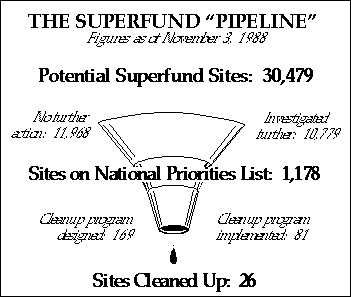Are there any environmentalists in the Environmental Protection Agency? It’s not an absurd question: EPA gets a lot of negative publicity, thanks to Anne Burford, a haltingly slow bureaucracy, and the recent radon gas scare (now widely considered overblown). But what about the folks in the trenches, who actually do the work of regulating hazardous waste and cleaning up Superfund sites?
Interviews with three employees of the regional office in Seattle revealed a broad range of environmental awareness within the EPA, from general concern to dedicated activism. "I would say that a majority of the people are very environmentally conscious and not just there to take home a paycheck" says Ted Wall, who manages cleanup efforts at four Superfund sites. He doesn’t belong to any outside environmental groups, but many others do.
David Bennett, for example, belongs to "just about all of them. Every year I find a new one to contribute to." Before coming to EPA, Bennett worked as an environmental activist for WashPIRG and coordinated its Hanford Nuclear Reservation project. Now an EPA National Priorities List Coordinator, he managed to get Hanford listed as a Superfund site – which he calls "a major coup."
Mike Stoner, a Superfund Site Manager who rides his bike to work for environmental reasons, gravitated towards hazardous waste cleanup from a background in soil science. "I went from doing basic research in pristine settings in Alaska, to looking at leakage from landfills, to working with the significantly contaminated sites" that Superfund was designed to clean up. Like his colleagues, Stoner must try to do the impossible with limited resources: "You might want to remove every single molecule of a hazardous waste from a site, but there’s just not enough money around to do that." (Superfund’s $8.5 billion budget must be spread between 30,000 currently identified potential sites – see figure at the end of this article.)
All three of those interviewed spoke well of their coworkers’ dedication and remain hopeful about the agency’s future. Says Bennett: "It’s a very powerful organization when it wants to be. If we chose to internally, and then the politicians let us, we could be a major force." In the EPA’s higher echelons, however, environmental activism becomes more rare and the atmosphere more politicized. But the morale crisis that descended during the time of Anne Burford’s administration (1981-83) has finally begun to lift. "I’m just thankful we don’t have that situation now, or I’d be very depressed" says Wall.
All three also acknowledged the important role played by environmental groups, even more strident ones like Earth First! and Greenpeace, in both educating the public and balancing the sometimes belligerent position of industry. (Nobody likes to be listed as a Superfund site.) But Bennett was not without criticism: "The guy from Earth First! comes in here with a styrofoam cup every time, and I give him hell for it."
Is the EPA a good place to work? "Not if you want to make a lot of money," says Bennett. Salaries run as much as one-half those of private industry, because the polluters can afford to pay so much more. "But if you’re looking for a challenge, you like stress and frustration, and you’re dedicated, this is the perfect place. Because we do have the capacity to effect major change."







